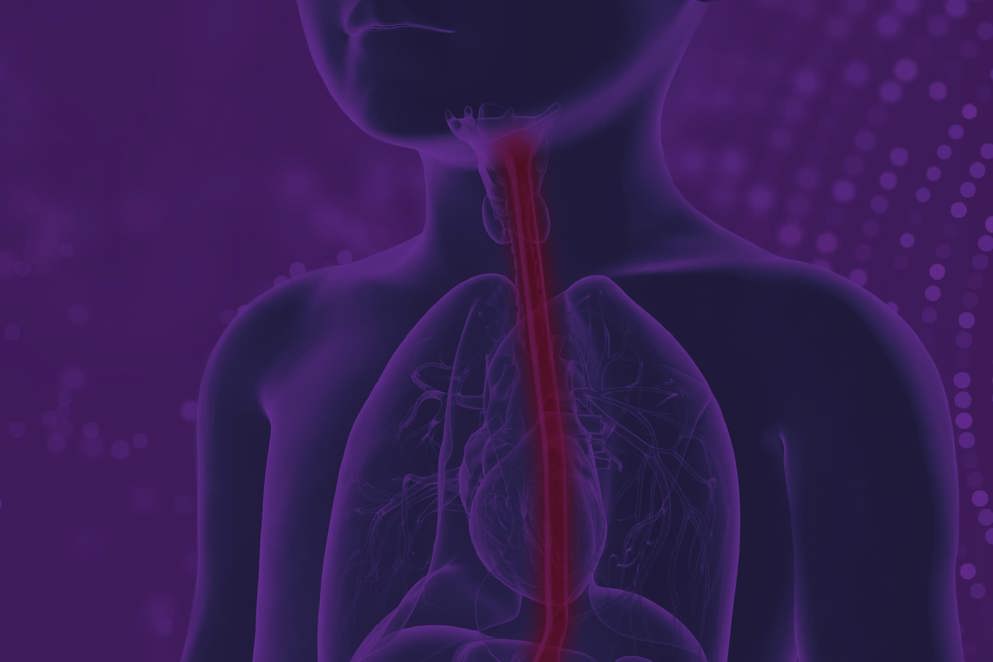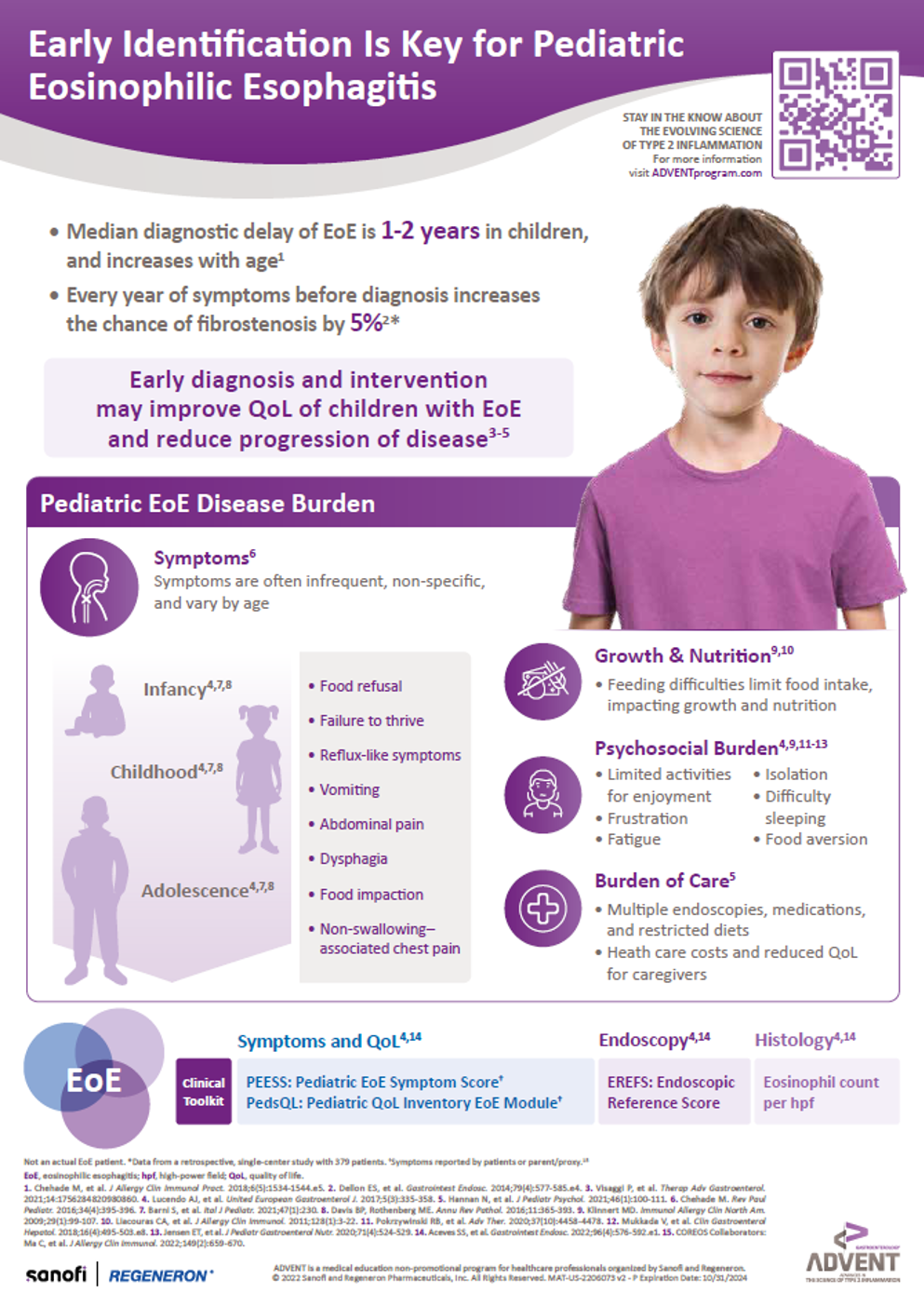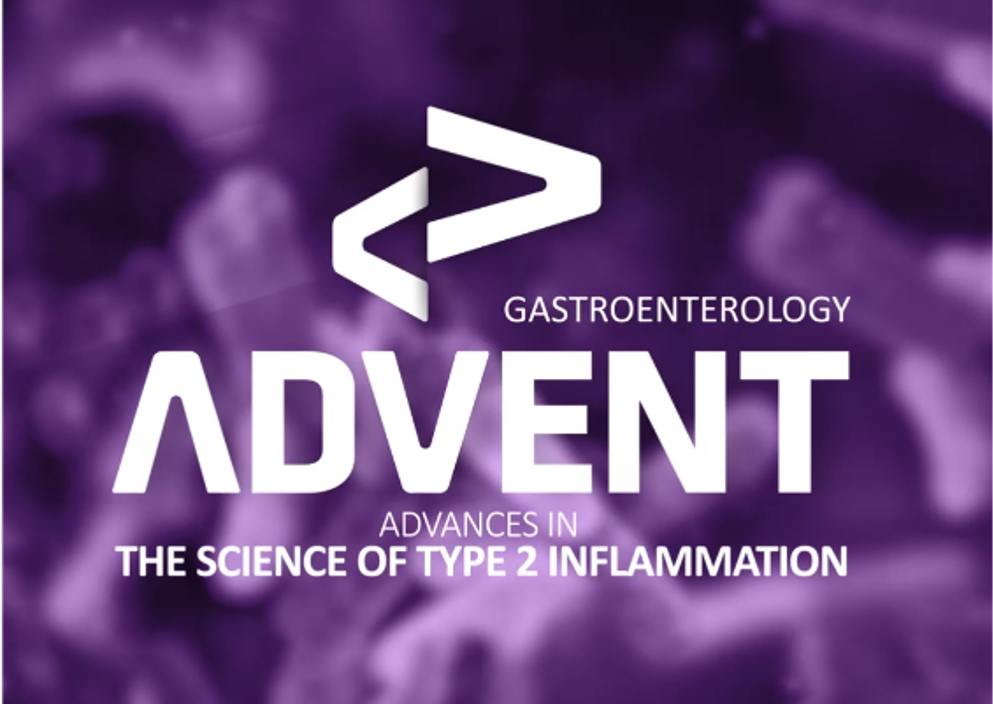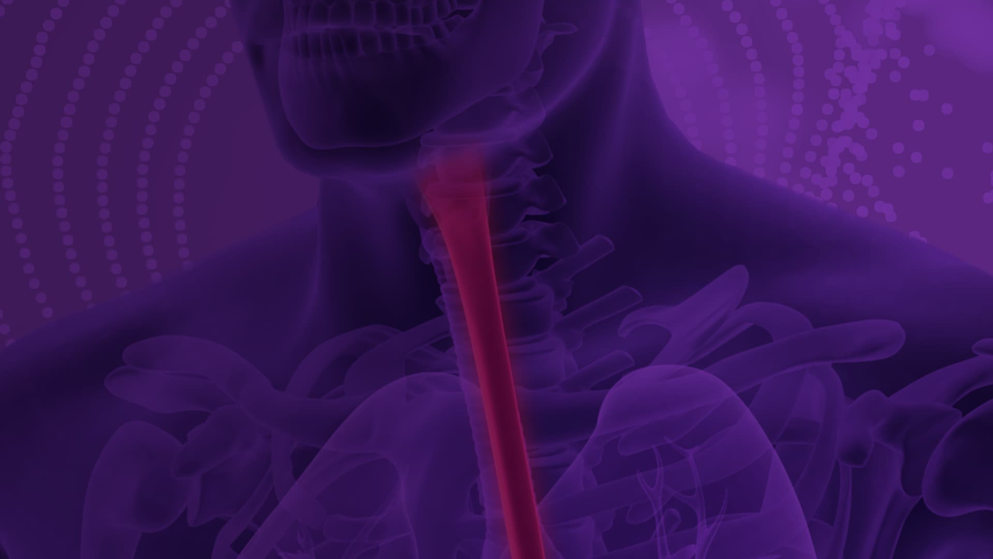
Pediatric Eosinophilic Esophagitis
Eosinophilic esophagitis is a chronic, progressive, type 2 inflammatory disease characterized by remodeling in the esophagus, dysphagia, food impaction, and significant patient burden1-3
Burden of Disease
Prevalence of pediatric EoE globally has been increasing since the early 2000s, with prevalence noted as high as 118/100,000 in 2018. EoE may occur at any age, with a rising incidence in children (FIGURE 1).1,2
FIGURE 1. Prevalence of EoE in Children <16 Years per 100,000 Inhabitants.1,2
EoE, eosinophilic esophagitis.
Symptoms of Pediatric EoE Impact Quality of Life for Patients and Families
Health-related quality of life is significantly worse in pediatric patients with more pronounced esophageal symptoms and histologic disease. Pediatric EoE can lead to discomfort or pain while eating, leading to food aversion. (FIGURE 2).2-5
FIGURE 2. Severe EoE Symptoms Impact Quality of Life in Children.2-5
EoE, eosinophilic esophagitis.
Untreated EoE Progresses to Fibrostenosis
Underlying type 2 inflammation drives progression toward a fibrostenotic phenotype in untreated EoE, pointing to early intervention in pediatric EoE as a key strategy to improve long-term outcomes for pediatric patients
(FIGURE 3).2,6-11
FIGURE 3. Untreated EoE Results in Progressive Remodeling and Fibrosis Over Time.2,6-11
Endoscopic images of the esophagus (left to right): First and second provided by U. von Arnim, last image from Hirano I, et al.9
Reproduced from Hirano I, et al.31 with permission from BMJ Publishing.
EoE, eosinophilic esophagitis; ILC2, type 2 innate lymphoid cell; Th2, T helper type 2.
Coexisting Type 2 Inflammatory Diseases Add to Burden
Type 2 inflammatory diseases commonly coexist in patients with EoE. Comorbid conditions with EoE can increase the impact on family health-related quality of life. Atopic comorbidities (asthma, atopic dermatitis, food allergy) should increase clinical suspicion of EoE (FIGURE 4).12,13
FIGURE 4. Additional Type 2 Inflammatory Diseases Commonly Coexist in Pediatric Patients With EoE.12,13
EoE, eosinophilic esophagitis.
Type 2 Inflammation Underlies Pediatric EoE
Pediatric EoE is a chronic, progressive disease of the esophagus characterized by inflammation and poor quality of life. Underlying type 2 inflammation is characterized by the presence of eosinophils and mast cells, along with cytokines such as IL-4 and IL-13 that drive the cycle of type 2 inflammation (FIGURE 5).2,6,8,10,11,14-16
FIGURE 5. Underlying Type 2 Inflammation Drives the Chronic Progression of EoE in Children.2,6,8,10,11,14-16
Adapted from Dellon ES, Hirano I.6 with permission from Elsevier.
EoE, eosinophilic esophagitis; ILC2, type 2 innate lymphoid cell; QoL, quality of life; Th2, T helper type 2.
Type 2 inflammation underlying EoE involves a variety of cell types and cytokines which drive disease progression. Though EoE is associated with eosinophil counts, EoE pathophysiology is not solely mediated by eosinophils
(FIGURE 6).2,17-19
FIGURE 6. Underlying Type 2 Inflammation Involves Many Cell Types and Cytokines Which Drive Disease.2,17-19
*Eosinophil activation and recruitment to the esophagus in EoE are mediated by key type 2 cytokines (IL-4, IL-13, IL-5).
EoE, eosinophilic esophagitis; eos/hpf, eosinophils per high-powered field; IL, interleukin; ILC2, type 2 innate lymphoid cell; TGF-β, transforming growth factor beta; Th2, T helper type 2.
Early Identification of Pediatric EoE
Early identification of EoE is vital in order to monitor the disease and prevent progression to fibrosis.6,17
EoE diagnosis requires a comprehensive assessment of clinical symptoms, histologic and endoscopic findings, and exclusion of non-EoE disorders (FIGURE 7).2,4,17
FIGURE 7. EoE Diagnostic Criteria (AGREE Consensus Guidelines). 2,4,17
*Non-EoE disorders that cause or potentially contribute to esophageal eosinophilia include hypereosinophilic syndrome, non-EoE eosinophilic gastrointestinal disorders, GERD, achalasia, Crohn’s disease, infections, connective tissue disorders, and drug hypersensitivity reactions.17
AGREE, A Working Group on PPI-REE; EoE, eosinophilic esophagitis; EGD, esophagogastroduodenoscopy; eos/hpf, eosinophils per high-power field; GERD, gastroesophageal reflux disease; PPI, proton-pump inhibitor; PPI-REE, PPI-responsive esophageal eosinophilia.
Early Identification Is Key for Pediatric Eosinophilic Esophagitis
Learn more about disease identification, including the common signs and symptoms of EoE in pediatric patients.
Download: Early Identification Is Key for Pediatric EoE Infographic
Recognizing Pediatric EoE Can Be Difficult
Recognizing EoE in pediatric patients can be difficult, in that symptoms often overlap with those of other pediatric diseases. Additionally, pediatric patients will often use masking to cope with the symptoms of EoE. Therefore, it is important to ask questions about eating and masking behaviors if pediatric EoE is suspected. (FIGURE 8).18,20-22
FIGURE 8. Diagnosis of EoE in Children Is Challenging Due to the Broad Spectrum of Symptoms That Vary by Age.18,20-22
*Data from 492 patients from 26 European pediatric gastroenterology clinics diagnosed with EoE between December 1999 and June 2016.20
CD, celiac disease; EoE, eosinophilic esophagitis; GERD, gastroesophageal reflux disease; SD, standard deviation.
Clinical Management
Clinical Management for Pediatric EoE
Current treatment paradigms for pediatric EoE involve dietary and/or medical interventions. Ongoing clinical trials in pediatric EoE populations are investigating the efficacy of swallowed topical corticosteroids and therapeutics which address underlying type 2 inflammation (FIGURE 9).2,23-25 Treatment guidelines and approval status for therapeutics may vary by region.
FIGURE 9. Potential Treatments for Pediatric EoE Include a Variety of Approaches. 2,23-25
EoE, eosinophilic esophagitis; STC, swallowed topical corticosteroid.
Transitioning From Pediatric to Adult Care
Chronic, progressive nature of type 2 inflammation in EoE requires a multidisciplinary approach to care from childhood to adulthood (FIGURE 10).18,26-28
FIGURE 10. Transitioning From Pediatric to Adult Care for EoE Patients.18,26-28
EoE, eosinophilic esophagitis.
ADVENTprogram.com
Learn more about type 2 inflammation
References
- Navarro P, et al. Aliment Pharmacol Ther. 2019;49(9):1116-1125.
- Lucendo AJ, et al. United European Gastroenterol J. 2017;5(3):335-358.
- Klinnert MD. Immunol Allergy Clin North Am. 2009;29(1):99-107, x.
- Davis BP, Rothenberg ME. Annu Rev Pathol. 2016;11:365-393.
- Munoz-Persy M, et al. Eur J Pediatr. 2018;177(5):649-663.
- Dellon ES, Hirano I. Gastroenterology. 2018;154(2):319-332.e3.
- Aceves SS, et al. J Allergy Clin Immunol. 2010;126(6):1198-1204.e4.
- Wechsler JB, Bryce PJ. Gastroenterol Clin North Am. 2014;43(2):281-296.
- Hirano I, et al. Gut. 2013;62(4):489-495.
- Doherty TA, et al. J Allergy Clin Immunol. 2015;136(3):792-794.
- Barni S, et al. Ital J Pediatr. 2021;47(1):230.
- Chehade M, et al. J Allergy Clin Immunol Pract. 2018;6(5):1534-1544.e5.
- Klinnert MD, et al. J Pediatr Gastroenterol Nutr. 2014;59(3):308-316.
- Muir AB, et al. Gastrointest Endosc Clin N Am. 2016;26(1):187-200.
- Bolton SM, et al. Am J Gastroenterol. 2020;115(2):224-233.
- Papadopoulou A, Dias JA. Front Pediatr. 2014;2:129.
- Dellon ES, et al. Gastroenterology. 2018;155(4):1022-1033.
- Hirano I, Furuta GT. Gastroenterology. 2020;158(4):840-851.
- Chehade M, et al. Gastro Hep Advances. 2022;1(5):720-732.
- Hoofien A, et al. J Pediatr Gastroenterol Nutr. 2019;68(4):552-558.
- Visaggi P, et al. Therap Adv Gastroenterol. 2021;14:1756284820980860.
- Chehade M. Rev Paul Pediatr. 2016;34(4):395-396.
- Molina-Infante J, et al. Aliment Pharmacol Ther. 2014;40(8):955-965.
- Molina-Infante J, van Rhijn, BD. Best Pract Res Clin Gastroenterol. 2015;29(5):749-758.
- Gandhi NA, et al. Nat Rev Drug Discov. 2016;15(1):35-50.
- Williamson P, Aceves S. Curr Gastroenterol Rep. 2019;21(11):56.
- Tourlamain G, et al. J Pediatr Gastroenterol Nutr. 2020;71(1):83-90.
- Hirano I. Gastroenterology. 2018;155(3):601-606.
of interest
are looking at
saved
next event
Developed by EPG Health for Medthority in collaboration with Sanofi and Regeneron, with content provided by Sanofi and Regeneron.
ADVENT is a medical education non-promotional program for healthcare professionals organized by Sanofi and Regeneron. This website is intended only for duly authenticated healthcare professionals.
© 2024 Sanofi and Regeneron Pharmaceuticals, Inc. All Rights Reserved.
MAT-US-2209565 v2.0 - P Expiration Date: 01/17/2025
Sanofi and Regeneron are committed to providing resources to advance knowledge in areas of unmet medical need among patients with inflammatory and immunologic diseases.




